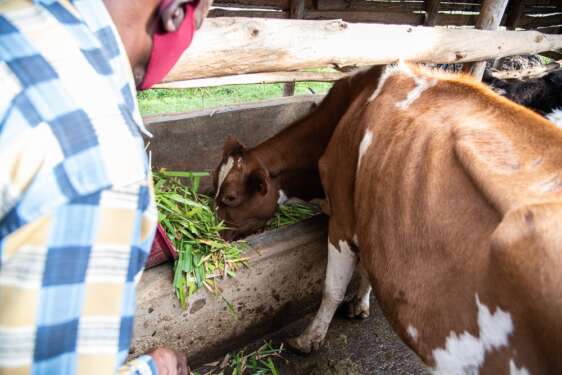Dairy is a big opportunity in Kenya with production hitting over 5 billion litres of milk a year.
This production is growing with innovations and better research which is helping farmers improve the lot for their livestock. According to the International Livestock Research Institute (ILRI), Kenyans consume more milk than people in any other country in Africa, and the demand for dairy products is on the rise.
By 2030, Kenya is likely to become a net dairy exporter.
Read: Women’s critical role in meeting Africa’s animal products demands
Around 80 per cent of Kenya’s dairy sector is made up of small-scale, informal dairy producers who without support, high production costs and rising consumer demand for higher-grade milk threaten to cripple their small-scale dairy entrepreneurship.
A change could be on the horizon. With increasing pressure to pursue ‘low-carbon agricultural development in Kenya, support for dairy farmers who can help reduce harmful greenhouse gas emissions from their cattle is increasingly likely at the policy level.
But, research and innovation is already bearing fruit.
More than 1,000 dairy farmers in Western Kenya have doubled their milk production and grown their incomes by saving on high-cost feed and growing their own high-quality, drought-resilient forage grasses.
Researchers have been working with farmers to test ten new varieties of grasses that are higher in protein, lower in fibre and mature faster. They boost both the quality and quantity of milk.
Through trainings and use of demonstration plots, the Grass to Cash project of the Alliance of Bioversity International and the International Centre for Tropical Agriculture (CIAT), has been working with smallholder farmers in Siaya, Kakamega, Bungoma and Busia counties since September 2018.
Dickson Osogo, a dairy farmer in Siaya County, joined the research work two years ago. He had three cows and struggled with high commercial feed prices and poor quality Napier grass. Dickson joined the Grass to Cash project out of curiosity and now, having attended training and tried new planting, farm management, harvesting and feeding methods, he has bought two more cows and set aside half an acre on his farm to cultivate the grasses himself, cutting costs.
“When I first planted the cultivars and fed them to my cows alongside napier, I noticed the cows preferred the cultivars,” Osogo said.
“This motivated me to expand the area under production. Now I have recorded an increase of up to six litres of milk per cow from milking twice per day. I don’t use a lot of grass when feeding them as I used to with Napier. The grasses also mature fast. When I first planted them, they matured within 10 weeks.”
He has increased his monthly income from selling milk from Ksh 11,015 (US$100) to Sh37,500 (US$340) since introducing the grasses.
Dickson is now a peer trainer with Send a Cow, a partner organization of the Alliance, working with 3,000 vulnerable farmers to improve their nutrition, health and income opportunities in the region. He trains 35 farmers in Siaya County, demonstrating the benefits of the grasses through sharing his experience.
He also gives interested farmers forage seeds, and visits their farms to advise them on good farm management practices for optimum grass yields.
Read: Investors flock Uganda’s Dairy farming industry
Ruth Odhiambo, a senior research assistant at the Alliance who worked with farmers to test the new grass varieties, said that the biggest problem farmers in Western Kenya faced was lack of animal feed.
Up to 80 per cent of farmers relied on napier, which has serious disease problems and which hinders grass production. Finding quality grasses and seed with high protein content, which could translate to improved milk yields and incomes, has been a real challenge for farmers.
The Kenya Agriculture and Livestock Research Organization (KALRO) tested the grasses for suitability in local conditions before they were released to farmers.
David Miano, a forage agronomist at KALRO, said: “As we think of making agriculture a business, we need to explore how we can convert what we are researching into a money making activity. We have worked with development partners and farmer organizations to disseminate the forages, and each partner has had a crucial role to play in making these new grasses available to as many farmers as possible.”
Advantage Crops, a partnering seed company, has collaborated with the research teams to commercialize some of the new forage seed varieties, making them more easily available to farmers within shorter distances and addressing seed shortages. They have also repackaged the seed into more affordable sizes, from 50 gram packs to one-kilogramme packs which vary in price from around 3,700 to 4,000 Kenyan Shillings per kilogram (US$33-36) depending on the variety.
Charles Wasonga, Company Director at Advantage Crops, said: “This is a great opportunity for farmers, whether they own cows or land, to step forward and venture into a different direction, in which their farming enterprises can be profitable. There is a need to intensify these campaigns so that more of the potential beneficiaries can experience what the alternative fodders can offer.” He added that young people without cattle are also benefitting, growing the fodder and selling it to farmers, encouraging new entrepreneurial, income-generating opportunity.
The Grass to Cash project is a project of the Alliance of Bioversity International and the International Centre for Tropical Agriculture (CIAT), in partnership with The Kenya Agriculture and Livestock Research Organization (KALRO), Advantage Crops Limited and Send a Cow and farmers.
Kenya’s dairy industry accounts for 5 per cent to 8 per cent of the country’s total GDP. This means that innovations in dairy farming offer significant potential to improve the livelihoods of thousands and this is where new industry actors are emerging to transform dairy farming in Kenya.
As it is, dairy farming in Kenya is one of the lucrative agricultural activities with so much potential. Kenya has an estimated 9,350,000 dairy cows, a number which is expected to keep growing as demand for milk and milk products soars.
